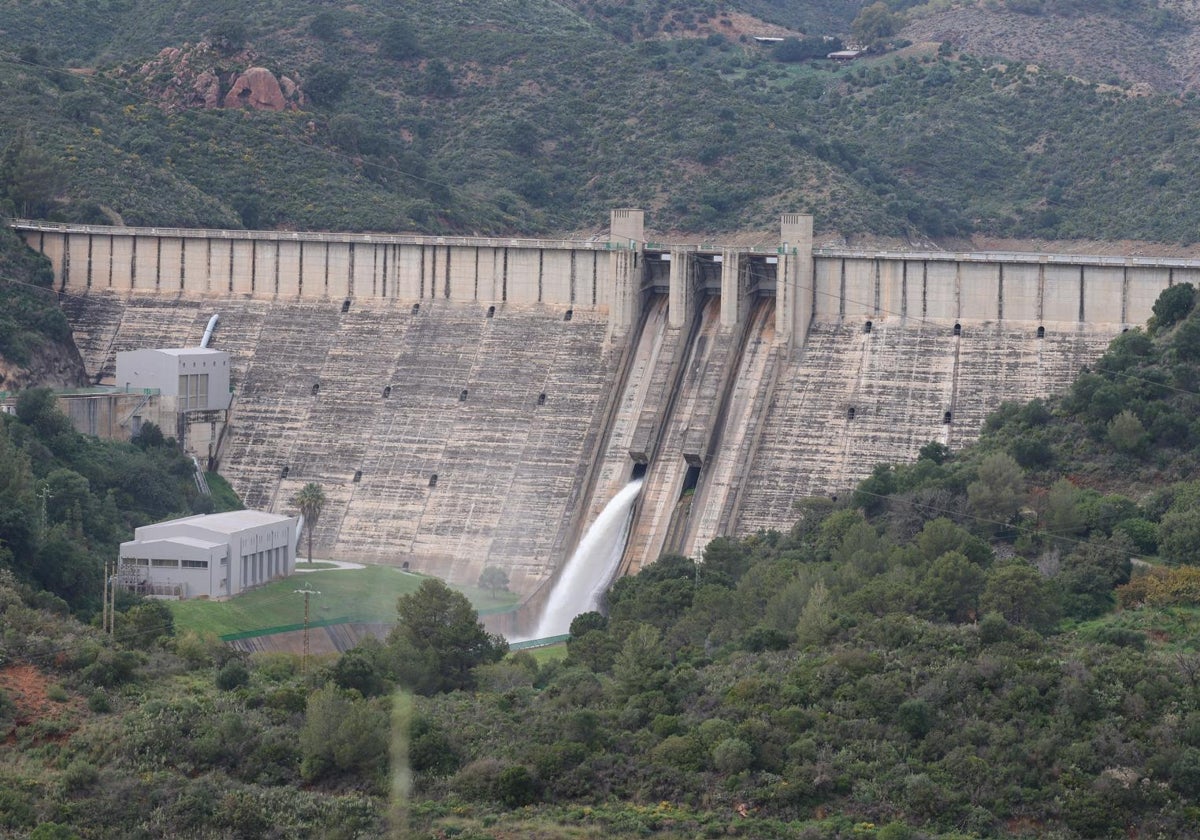Why can't the excess water in an almost full Costa del Sol reservoir be diverted elsewhere when needed?
For safety reasons, La Concepción reservoir near Marbella - which supplies much of the western strip of the Malaga province coast - has been discharging up to 60 cubic metres per second in the last few days
It is a shameful state of affairs for the Costa del Sol and has been repeated for decades. According to the latest bathymetry data which measures the depth and volume of water stored, La Concepción reservoir has a capacity of just over 57 million cubic metres. It is a very well designed reservoir, inaugurated in 1972, and to which a triple transfer was added in the 1990s, bringing in water from the Guadalmina, Guadalmansa and Guadaiza rivers, which are added to the Verde, the main river in the water catchment basin. All the rivers originate in the mountains surrounding the Sierra de las Nieves, the Genal valley or the Serranía de Ronda and draw a lot of water as the water courses are short and the slopes are steep.
1. The Costa del Sol needs 90 million cubic metres per year
Nowadays the Costa del Sol needs 90 million cubic metres of water every year, a far cry from the needs of 50 years ago. So, what has been happening in these last few days of rainfall? Since Friday La Concepción's dam has been releasing excess water into the sea in a controlled and monitored manner with outflows of between 10 and 60 cubic metres per second. To grasp what is being lost: Malaga city takes in 1.5 cubic metres per second from the network. That is a lot of water to lose. So it is a question, for safety's sake, of maintaining a flat curve of between 47 and 48 million cubic metres of water stored in the reservoir. Put bluntly, it is all about balancing what the rivers contribute and what comes down as rain with maintaining a stable volume and filling rate. Nevertheless, the balance is being managed without incident.
2. Why not send water just as is, untreated?
The next logical questions are, firstly, can this water not be transferred elsewhere? The blunt answer is no. And secondly, why not? The first idea that someone could come up with is to send raw (unfiltered, not yet classed as drinking water) water to Malaga city. However, the mains network is in a very bad state and Acosol and the Junta are preparing a plan worth millions to install a new high-capacity pipeline, starting with the most needy area: Benalmádena.
3. If Malaga and the Axarquía send treated water to each other, why is the same not done here?
The second idea, like what is done between Malaga and Axarquia, would involve Acosol making water drinkable at the Verde drinking water treatment plant (DWTP) and sending it to Malaga via the Rojas (Churriana) bypass, which has recently been doubled in capacity thereby allowing a two-way exchange of flows at a rate of 500 litres per second, a third of Malaga city's consumption.
However, drinking water cannot be sent because the aforementioned Verde DWTP is incapable of doing so and is obsolete. The previous Junta de Andalucía abandoned the project in 2009. The incumbent regional ministry of agriculture and Acosol have resumed this work and are in the tendering phase for its modernisation and duplication, which includes two huge reservoirs. This 35 million-euro project will increase the amount of drinking water to 4,600 litres per second. That is more than enough to guarantee supply not only for the summer peaks on the coast but also to guarantee transfers to Malaga. Then from there to the Axarquía.
4. And if the Costa del Sol uses only the reservoir and turns off the desalination plant and wells...?
Next one might ask why not close all the resources and drink only water from La Concepción so that no water has to be released from the reservoir? Again, this is because of the incapacity of the Verde DWTP to handle this. Even so, Acosol has given the wells of Guadalmansa and Fuengirola a break during these days of heavy rains and has reduced the desalination plant at Marbella to three lines of production. The desalinated water is mixed in the discharge pipe with the water coming from the reservoir.
5. Why can't La Concepción be rebuilt and what about Gibralmedina?
The need to dam more water for the Costa del Sol led to the inclusion of the enlargement of La Concepción dam in Spain's national hydrological plan, but this project has now been pretty much ruled out. Instead, the project has been replaced in the Junta's plans by the Gibralmedina reservoir at the provincial border between Cadiz and Malaga, which will regulate the flows from the Guadiaro river. The project has been drawn up and is expected to transfer 15 million cubic metres every year to the Costa del Sol.

